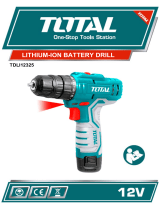Makita M602D is a versatile power tool designed for a wide range of drilling and screw driving tasks in various materials like wood, metal, and plastic. It features two speed settings for optimal performance in different applications. The high-speed setting (0-1,300 rpm) is ideal for drilling precise holes, while the low-speed setting (0-400 rpm) provides the necessary torque for driving screws securely. The maximum drilling capacity of Makita M602D is 13 mm in steel and 28 mm in wood, allowing you to tackle a variety of projects efficiently. Additionally, its lightweight design (2.
Makita M602D is a versatile power tool designed for a wide range of drilling and screw driving tasks in various materials like wood, metal, and plastic. It features two speed settings for optimal performance in different applications. The high-speed setting (0-1,300 rpm) is ideal for drilling precise holes, while the low-speed setting (0-400 rpm) provides the necessary torque for driving screws securely. The maximum drilling capacity of Makita M602D is 13 mm in steel and 28 mm in wood, allowing you to tackle a variety of projects efficiently. Additionally, its lightweight design (2.








-
 1
1
-
 2
2
-
 3
3
-
 4
4
-
 5
5
-
 6
6
-
 7
7
-
 8
8
Makita M602D is a versatile power tool designed for a wide range of drilling and screw driving tasks in various materials like wood, metal, and plastic. It features two speed settings for optimal performance in different applications. The high-speed setting (0-1,300 rpm) is ideal for drilling precise holes, while the low-speed setting (0-400 rpm) provides the necessary torque for driving screws securely. The maximum drilling capacity of Makita M602D is 13 mm in steel and 28 mm in wood, allowing you to tackle a variety of projects efficiently. Additionally, its lightweight design (2.
Ask a question and I''ll find the answer in the document
Finding information in a document is now easier with AI
Related papers
Other documents
-
Ronix 8614K User manual
-
 Total TDLI12325 Lithium-Ion Battery Drill Owner's manual
Total TDLI12325 Lithium-Ion Battery Drill Owner's manual
-
Ronix 8612C User manual
-
Ronix 8616K User manual
-
Maktec MT060 User manual
-
Northern Industrial Tools 6217D User manual
-
Ronix 8018 User manual
-
Ronix 8614 User manual
-
Ronix 8613 User manual
-
Ronix 8905K 20V Brushless Hammer Drill Driver User manual








